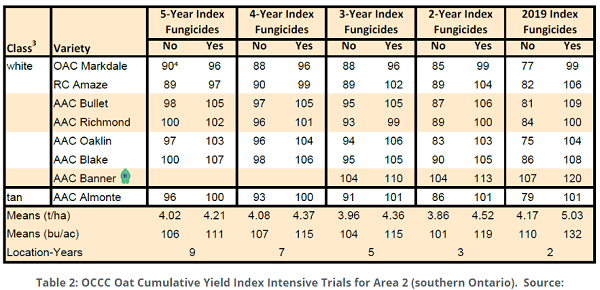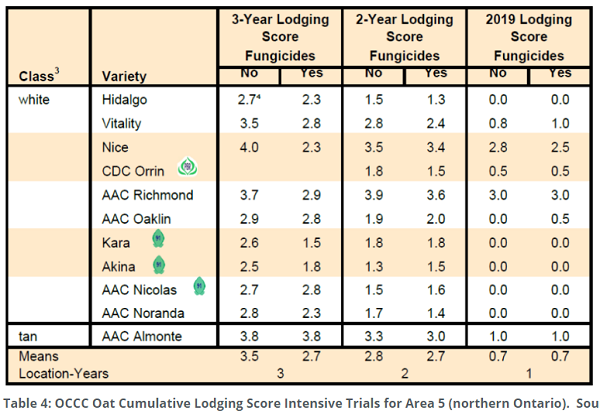When we think about fungicide applications we naturally think about protection from disease. However, there has been more discussion and reflection about the additional benefits that fungicides may provide including an improvement in overall plant health and harvestability of a crop. This was something that was discussed at the Ontario Cereal Crop Committee (OCCC) table this fall as we made some interesting observations in the response of oat varieties to fungicide applications in various regions.
As part of the OCCC performance trials, fungicide applications are made to be able to give producers a comparison on the performance of varieties in both an unmanaged and managed scenario. This is important as it helps producers select varieties that are best suited to their operation and also helps determine whether or not a fungicide application may be warranted for the variety they have selected to grow.
In the oat performance trials, fungicide applications are made around GS 39 (Flag leaf ligule/collar just visible) to control leaf disease. A fungicide application is made at this time for the management of crown rust which is considered to be the most important disease in Ontario oat production and to reflect the practices of Ontario producers. The OCCC oat performance data has historically focused on the yield and crown rust response of fungicide applications which has highlighted the differences in response between both varieties and location. Some varieties show a greater response to fungicide applications than others and southern/eastern Ontario locations have shown a greater response to fungicide applications compared to northern Ontario. This is due to the fact that there is very little to no disease pressure in northern Ontario year over year compared to southern/eastern Ontario. As a result, growers in northern Ontario or growers who have historically not had to deal with crown rust, may opt not to make a fungicide application to their oat crop. However, an interesting observation was made in the oat lodging data in addition to the yield and disease responses that may need to be taken into consideration when making fungicide application decisions.

Table 1 highlights the clear trend of fungicide applications showing very little to no yield response in oats grown in northern Ontario. When looking at the 5-year yield index you can see that the greatest difference between with and without a fungicide application is only 4 index points (values differing by less than 3 are considered equal). Additionally, this response is limited to two varieties Hidalgo and AAC Noranda over five years of data while all other varieties have a difference of 3 index points or less demonstrating that there was no yield response to a fungicide application in northern Ontario. Furthermore, it is interesting to see that in 2019; a low disease year for northern Ontario, there was actually a negative yield response by some varieties to a fungicide application. Southern and eastern Ontario once again dealt with crown rust in the performance trials and showed an average of 22 bu/ac more in the with fungicide treatments in southern Ontario (Table 2) and an average of 8 bu/ac more in fungicide treatments in eastern Ontario (Table 3).


As you look at this data you might say “well, its simple – there is no point in making fungicide applications in the absence of disease or if I am a grower in northern Ontario”. However, it may not be that simple and the lodging data shows an interesting story. While in 2019 there was no differences in lodging between the with and without fungicide applications in northern Ontario, the 3-year lodging data that is currently available does show a significant lodging response between the with and without fungicide treatments (table 4).

When looking at the data you can see that the average lodging score is 1.2 points lower when a fungicide application is made (a low lodging score is desired). For a variety such as Nice, the difference in lodging score between a with and without fungicide treatment is even greater at 1.7. While this may not seem like a lot, in some instances this could mean the difference between nicely combining a crop at average speed to scraping the crop off the ground and losing both yield and quality. As one would expect, the differences in lodging score is even greater for southern and eastern Ontario. Southern Ontario had an average lodging score that was 3.8 points lower in the fungicide treatments and eastern Ontario had an average score that was 3.1 points lower in the fungicide treatments.
While lodging data isn’t the only factor we base our management decisions on, it is an important one that shouldn’t be overlooked in oat production. This data also doesn’t necessarily mean that a fungicide application should be made on every oat acre but that you should have an even deeper understanding about the varieties you choose to grow on your operation and how you manage those varieties according to the responses they have shown to various management regimes and location. Yield, quality and disease resistance are still some of the most important factors that need to be taken into consideration.